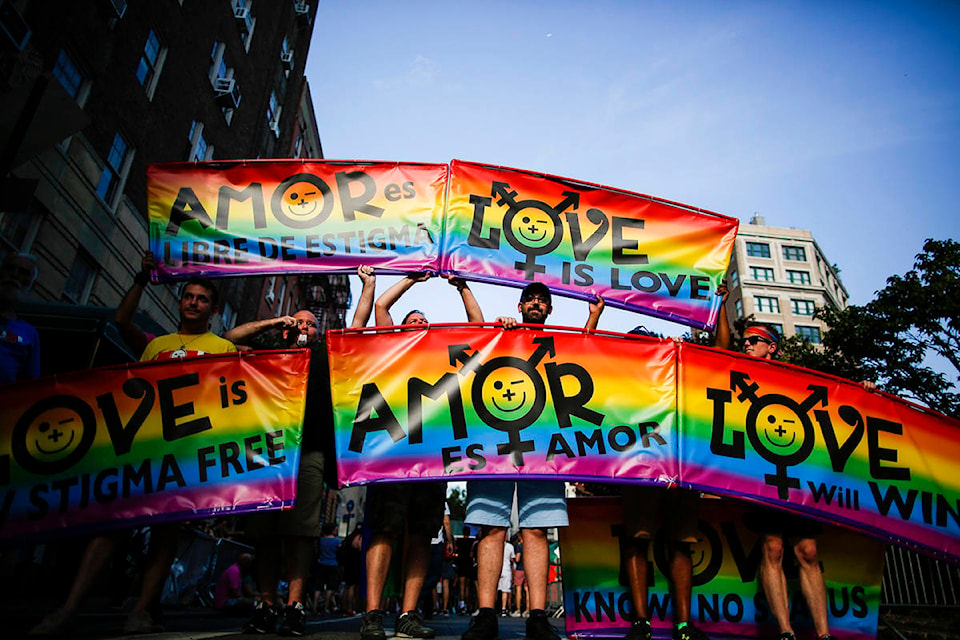Crowds gathered outside New York’s historic Stonewall Inn on Sunday to celebrate five decades of LGBTQ pride, marking the 50th anniversary of the police raid that sparked the modern-day gay rights movement. Other cities throughout the country held parades.
More than 2,000 people gathered outside the bar where patrons resisted the famous June 28, 1969, police raid. Thousands also turned out for a larger parade that packed Fifth Avenue, where rainbows were on display across everything from flags to T-shirts.
Eraina Clay, 63, of suburban New Rochelle, came to celebrate the anniversary.
“I think that we should be able to say we’ve been here for so long, and so many people are gay that everybody should be able to have the chance to enjoy their lives and be who they are,” Clay said. “I have a family. I raised kids. I’m just like everybody else.”
Alyssa Christianson, 29, of New York City, was topless, wearing just sparkly pasties and boy shorts underwear. A Pride flag was tied around her neck like a cape.
“I’ve been to the Pride parade before, but this is the first year I kind of wanted to dress up and get into it,” she said.
Christianson said she is concerned that the movement could suffer setbacks during the Trump administration, which has moved to revoke newly won health care protections for transgender people, restrict their presence in the military and withdraw federal guidance that trans students should be able to use bathrooms of their choice.
“I’m definitely a little scared of how things are going, just the anger and violence that comes out of it and just the tone of conversation about it. We’ve come so far, especially in the last few decades, that I don’t want to see that repressed in any way.”
PHOTOS: Hundreds gather at Stonewall 50 years after LGBTQ uprising
In May, Trump tweeted about Pride Month and praised the “outstanding contributions” of LGBT people. But his administration has also aligned with some religious conservatives in arguing that nondiscrimination protections for those same people can infringe on the religious beliefs of others who oppose same-sex marriage and transgender rights.
At the Queer Liberation March near the Stonewall Inn, some participants said the larger Pride parade had become too commercialized and heavily policed.
“What’s important to remember is that this is a protest against the monetization of the Pride parade, against the police brutality of our community, against the poor treatment of sections of our community, of black and brown folk, of immigrants,” said Jake Seller, a 24-year-old Indiana native who now lives in Brooklyn and worked as one of the march’s volunteers.
Protesters carried anti-Trump and queer liberation signs, chanting, “Whose streets? Our streets!”
“We march for the liberation of our community so they can live and celebrate their identity. So they can reclaim it. This will always remain a protest, not an advertisement,” Seller said.
Happy Pride! #ChicagoPride #ChicagoProud2019 pic.twitter.com/HDj1Jn8eK4
— Mayor Lori Lightfoot (@chicagosmayor) June 30, 2019
Other attendees focused on the progress that’s been made within the LGBTQ community over the last few decades.
“We’ve come so far in the past 20 years,” said 55-year-old Gary Piper, who came from Kansas to celebrate Pride with his partner. “I remember friends who would be snatched off the streets in Texas for dressing in drag. They’d have to worry about being persecuted for their identity.”
“But now we’re so much more accepted. I’m not saying we don’t have ways to go, but let’s celebrate how far we’ve come,” he said.
The police presence at the march was heavy, with several officers posted at every corner. Metal barricades were erected along the entire parade route.
In Illinois, Gov. J.B. Pritzker chose the parade day to sign an executive order creating a task force to study the rights of transgender students. The task force will look at what schools are doing to promote LGBTQ rights to make sure students have “welcoming” and “inclusive” environments.
Chicago had its own Pride parade, with Lori Lightfoot, the city’s first openly gay mayor, as one of seven grand marshals. Lightfoot, who took office in May, walked alongside her wife and wore a “Chicago Proud” T-shirt with rainbow lettering. The couple held hands at times, drawing cheers from onlookers.
This is a moment we’ll never forget. Thank you, Chicago! In honor of you all, here are a few of my favorite photos from #ChicagoPride. #ChicagoProud2019 pic.twitter.com/H69XUryIpX
— First Lady Amy Eshleman (@TheChiFirstLady) June 30, 2019
The parade was cut short as thunderstorms rolled through the area, forcing police to cancel the event about three hours after it began.
The larger New York Pride parade had 677 contingents, including community groups, major corporations and cast members from FX’s “Pose.” Organizers expected at least 150,000 people to march, with hundreds of thousands more lining the streets to watch.
The Pride march concludes a month of Stonewall commemorations in New York that included rallies, parties, film showings and a human rights conference. The celebration coincides with WorldPride, an international LGBTQ event that started in Rome in 2000 and was held in New York this past week.
Other Pride events will take place Sunday around the U.S. and the world.
In San Francisco, a contingent of Google employees petitioned the Pride parade’s board of directors to revoke Google’s sponsorship over what they called harassment and hate speech directed at LGBTQ people on YouTube and other Google platforms.
San Francisco Pride declined to revoke the sponsorship or remove the company from the parade, but Pride officials said the Google critics could protest the company’s policies as part of the parade’s “resistance contingent.”
Larraine and Peter Browne, who were visiting from Australia, told the San Francisco Chronicle they had never seen anything like the parade’s rainbow-colored display.
“Look at the costumes!” 80-year-old Peter Browne said.
ALSO READ: Students disciplined after anti-LGBTQ signs posted in Kamloops high school
___
Sabrina Caserta And Rebecca Gibian, The Associated Press
